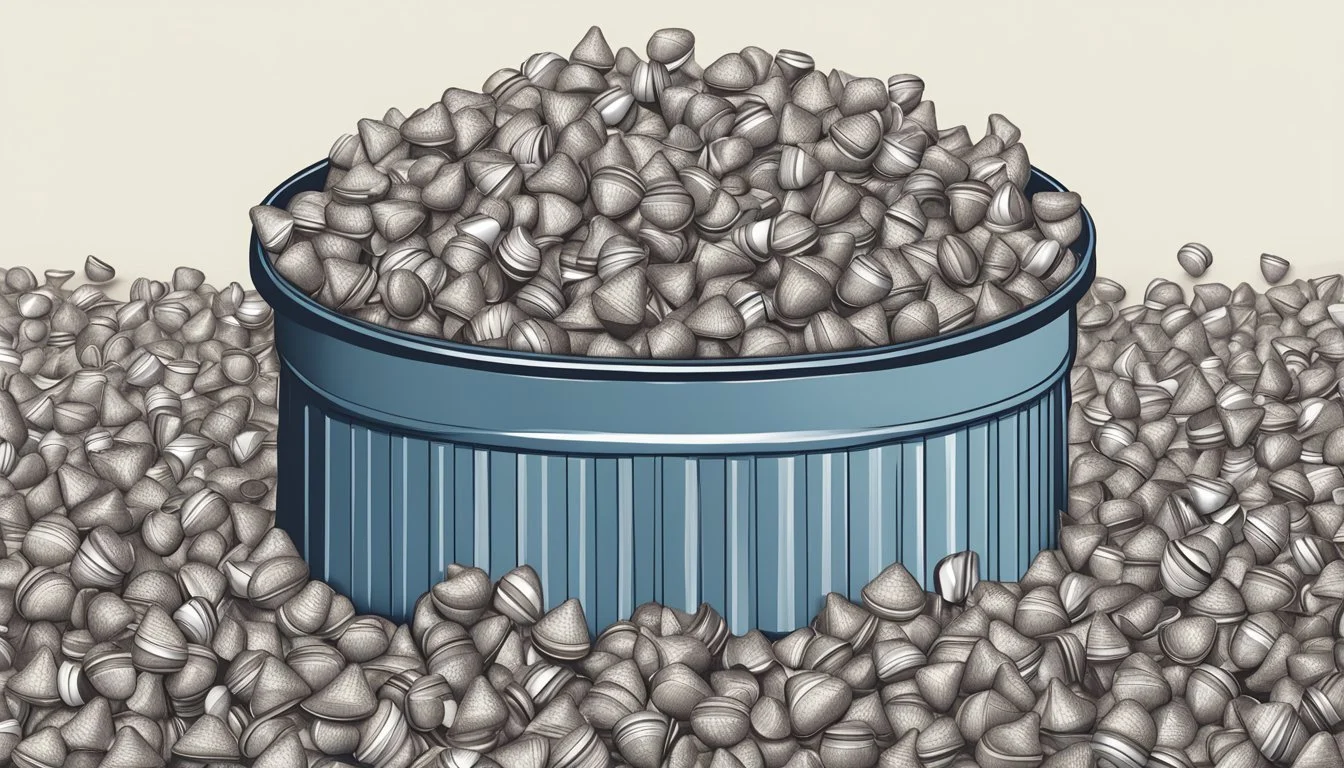How Much Hershey's Kisses Per Day Is Too Much?
Understanding Chocolate Consumption Limits
When it comes to indulging in chocolate, moderation is key. Hershey's Kisses, the iconic bite-sized treats, have been savored by people of all ages for their convenience and delicious taste. However, the question of how much is too much is important for maintaining a balanced diet. A serving of Hershey's Kisses consists of seven pieces, containing 160 calories, 9 grams of total fat, and significant amounts of sugar and saturated fats. While these confections bring delight to the palate, they also contribute to one's daily intake of calories, sugars, and fats.
Consuming chocolate, particularly dark chocolate, has been associated with certain health benefits such as improved heart health and lower blood pressure. Yet, it's crucial to understand that these advantages are usually linked to chocolate with high cocoa content and minimal processing. Hershey's Kisses, being milk chocolate, have additional ingredients like sugars and milk solids, which may counteract potential benefits when consumed in excess.
The dietary implications of consuming Hershey's Kisses can add up, especially when one considers that the recommended limit for added sugars is no more than 10% of one's daily caloric intake, according to the Dietary Guidelines for Americans. With approximately 18 grams of sugar in a single serving of Hershey's Kisses, they can contribute significantly to this limit. Analyzing the nutritional content and understanding the impact of Hershey's Kisses within the context of a daily diet helps consumers make informed decisions about their chocolate consumption.
Overview of Hershey's Kisses
Hershey's Kisses are an iconic chocolate treat known for their unique shape and variety. They originate from the Hershey Company, which has grown from a local chocolate maker in Pennsylvania to an international confectionery powerhouse.
History and Background
The Hershey Company began producing Hershey's Kisses in 1907. Initially, each chocolate was hand-wrapped, but by 1921, a machine was developed for automated wrapping. These chocolates are recognizable by their distinct conical shape, designed to resemble a teardrop, and each piece is wrapped in a square of lightweight aluminum foil. The plume or paper flag that sticks out from the top of each wrapper has become a hallmark of the Hershey's Kiss.
Product Range and Varieties
As the product line evolved, Hershey's introduced a range of flavors and varieties to delight consumers of all tastes. Here is a snapshot of the product range:
Filled Varieties: Including almonds, caramel, or chocolate truffle.
The chocolates are produced in Pennsylvania, and in terms of sheer volume, Hershey's makes over 70 million Kisses per day to meet global demand. This product line has stood the test of time and remains a staple in the company's portfolio.
Nutritional Information
This section provides a detailed look into the nutritional content of Hershey's Kisses, including ingredients, calories, and the breakdown of sugars and fats.
Ingredients and Nutrition Facts
Hershey's Kisses are primarily made from milk chocolate, which includes sugar, milk, chocolate, cocoa butter, milk fat, lecithin (soy), and natural flavor. In terms of nutrition facts, a standard serving size of 7 pieces (approximately 30g) contains around 160 calories. These chocolates are renowned for their creamy taste and smooth texture, which come from the careful balance of ingredients.
Caloric Content and Serving Sizes
One serving size of Hershey's Kisses, which is typically 7 pieces or about 30 grams, contains 150-160 calories. The specific caloric content can vary slightly based on the particular variety, for instance, the version with almonds has a slightly higher calorie count per serving. Understanding serving sizes is crucial when considering daily consumption to maintain balance in one's diet.
Sugar and Fat Breakdown
The sugar content in Hershey's Kisses is significant, with 18-19 grams of total sugar, which includes 16 grams of added sugar per serving. Regarding fat, they contain 9 grams of total fat, which involves 5-6 grams of saturated fat. This accounts for a substantial portion of the % daily value (%DV) for these nutrients, with saturated fat hitting around 30% of the recommended daily limit per serving, based on a 2,000 calorie daily diet. It is essential to monitor these values, particularly for individuals mindful of sugar and fat intake.
Health Considerations
In discussing health considerations for consuming Hershey's Kisses, one must assess the recommended daily intake, implications for weight management, and the potential health benefits and risks of chocolate.
Recommended Daily Intake and RDI
The recommended daily intake (RDI) of added sugars, which includes those found in sweets like Hershey’s Kisses, should not exceed 10% of total daily calories according to dietary guidelines. For a 2,000-calorie diet, this translates to about 50 grams of added sugar. Seven Hershey’s Kisses contain approximately 22 grams of sugar, nearly half the RDI for added sugars.
Weight Management and Overconsumption
Regular consumption of Hershey's Kisses can contribute to weight gain if not eaten in moderation, as they are calorie-dense and high in added sugars. Consuming them in excess may also have an impact on cholesterol levels due to their saturated fat content. A balance between indulgence and dietary restrictions can help maintain weight management.
Health Benefits and Risks
When consumed in small amounts, dark chocolate—unlike milk chocolate—has been associated with certain health benefits. It can contribute to a reduced risk of heart disease and an improvement in cholesterol profiles due to its content of cocoa polyphenols. However, Hershey's Kisses, particularly the milk chocolate variety, should be eaten sparingly, as overconsumption may outweigh these benefits and lead to potential health risks, including an increased burden on weight and iron absorption.
Special Varieties and Dietary Restrictions
In considering how much Hershey's Kisses one can consume daily, it's important to understand the variety of options available and their implications for those with dietary restrictions.
Dark, Milk, and White Chocolate Options
Hershey's Kisses come in a range of chocolate varieties to cater to different palates. For those who prefer a less sweet and more cocoa-rich flavor, dark chocolate Kisses are available. Milk chocolate Kisses are the classic choice, offering a creamy and sweet taste. For those who enjoy a sweeter, cocoa-butter-based option, white chocolate Kisses are an alternative. Making an informed choice between these types can influence dietary balance and sugar intake.
Gluten-Free and Allergen Information
Those with gluten sensitivities can enjoy Hershey's Kisses as they are generally considered gluten-free. However, individuals should always check packaging labels for the most current manufacturing and ingredient information. When considering allergens, milk chocolate varieties do contain dairy, and can therefore pose risks for individuals with milk allergies. Additionally, Hershey's products often contain soy lecithin, an emulsifier, which is essential to consider for those with soy allergies. It's crucial for consumers to be aware of these details to make choices that align with their dietary needs.
Consumption Advice
When determining how many Hershey's Kisses to eat per day, one must consider their individual caloric needs and nutritional goals. Moderation is key to enjoy this sweet treat without overindulging.
Determining an Optimal Daily Amount
To determine an optimal daily amount of Hershey's Kisses, individuals should first look at the calorie content. One individual Kiss is approximately 22 calories. Given that an average adult's diet may include 1,600 to 2,400 calories per day, depending on age, sex, and level of physical activity, Hershey's Kisses should be a small fraction of this intake.
Caloric Allocation for Hershey's Kisses:
Number of Kisses Total Calories 1 22 7 154 10 220
Consuming seven Hershey's Kisses will provide about 154 calories, which can fit into a balanced diet as a controlled sweet treat. An individual should factor in their remaining caloric intake for the day to decide if this fits within their dietary goals.
Balancing Indulgence and Health
Balancing the desire to indulge with the need for a healthful diet is a common FAQ for many individuals. A balance can be struck by considering the nutritional content of Hershey's Kisses in the context of one's overall diet. While indulgence is part of a balanced lifestyle, Hershey's Kisses should be consumed in moderation.
Nutrition Facts for Hershey's Kisses (per 7 pieces):
Total Fat Saturated Fat Sodium Total Carbs Sugars Added Sugars Fiber 9g 6g 25mg 19g 18g 16g <1g
One should consider not only the calories but also the sugars and fats in their daily allowance. Nutrition experts typically suggest keeping added sugars intake to less than 10% of total daily calories. Thus, if consuming other sources of added sugars throughout the day, one should reduce the number of Hershey's Kisses accordingly to maintain nutritional balance.
Packaging and Storage
The longevity and quality of Hershey's Kisses are significantly influenced by their distinctive packaging and the storage conditions they are kept in.
Packaging Types
Hershey's Kisses are renowned for their unique foil wrap which not only serves as a barrier to protect the chocolate from contaminants but also helps in maintaining the product's shape. The aluminum foil used is notably thin, measuring approximately .00035 inches in thickness, offering a light yet effective covering. In the context of retail packaging, Hershey's has committed to ensuring all plastic packaging is recyclable, reusable, or compostable by 2030, applying eco-friendly practices such as utilizing recycled materials in multi-pack carriers.
Storing Hershey's Kisses for Freshness
To preserve the quality of Hershey's Kisses, one should store them at a temperature between 55-70°F (13-21°C) and maintain a humidity level of less than 60%. This ideal environment prevents the chocolates from melting and retains freshness. While the outer foil provides some protection, once the retail package is opened, transferring the Kisses to an airtight container can extend their longevity, keeping them ready for safe consumption well before the "best by" date indicates a decline in quality.
Consumer Questions
In addressing consumer concerns, it is important to touch on the balance between enjoying treats like Hershey's Kisses and maintaining a healthy diet. Information gleaned from resources such as ingredient statements and guidelines provided by the FDA, USDA, and other regulatory bodies will be referenced to shed light on these consumer inquiries.
Frequently Asked Questions
How many Hershey's Kisses does it take to exceed daily recommended amounts of sugars and saturated fats?
According to nutrition information, consuming more than seven Hershey's Kisses could contribute significantly to the daily intake of sugars and saturated fats. This assumes no other sources of these nutrients are consumed.
Are there any toxic ingredients in Hershey's Kisses that consumers should be aware of?
Concerns have been raised about the presence of heavy metals in chocolate. Regulatory agencies like the FDA and EPA have established limits for these contaminants, and chocolate manufacturers are expected to comply with these standards to ensure safety.
Can Hershey's Kisses be part of a healthy diet?
Hershey's Kisses can fit into a balanced diet if consumed in moderation. Consumers should refer to the ingredient statement and nutrition facts for portion sizes and consider total caloric and nutrient intake as part of their overall dietary consumption.
What are the daily recommended limits for sugar and saturated fats according to the USDA?
The USDA recommends that added sugars make up less than 10% of daily calories and saturated fats less than 10% of daily calories. Individuals should consult their specific dietary needs based on these guidelines.
Manufacturing and Quality Standards
Hershey's Kisses are produced with advanced technology that meets stringent safety and quality regulations. The company has invested significantly to ensure that its products comply with food safety standards while keeping up with high production demands.
Production Process
The Hershey Company operates its manufacturing plants with a commitment to quality and efficiency. In Hershey, Pennsylvania, a $300 million investment resulted in one of the world's most technologically advanced chocolate making facilities. As part of the production process, Hershey ensures that all ingredients, such as soy, wheat, and dairy, are handled properly to prevent cross-contamination and to maintain the purity of the final product. The West Hershey plant operates around the clock to mold, wrap, and package millions of Hershey's Kisses each day.
Quality and Safety Regulations
Hershey takes its supply chain seriously, requiring business partners to adhere to a comprehensive Supplier Quality Expectations Manual. The company’s products are made in compliance with the food safety regulations of the USA. This includes regular quality checks and following protocols designed to ensure that all chocolate products meet the safety standards before they reach the consumer. Hershey’s manufacturing teams are responsible for making certain that every single Kiss is free from defects, such as the missing tips issue that was addressed promptly after feedback from consumers.
Sustainability and Social Responsibility
The Hershey Company strongly emphasizes its sustainability efforts and social responsibility. They focus on its environmental impact and community engagement, crucial pillars of their Shared Goodness Promise.
Environmental Impact
The Hershey Company takes significant steps to minimize its environmental footprint and operates with a sustainability strategy pointed toward safeguarding the ecosystem. Key efforts include:
Sustainable Sourcing: Hershey is committed to responsibly sourcing key ingredients. For example, the company aims to source 100% sustainable soy by a targeted year, aligning its goals with environmental standards.
Reduction in Emissions: Aligning with guidelines from entities like the Environmental Protection Agency (EPA), Hershey strives to reduce emissions across its operations in the USA and worldwide, demonstrating its dedication to combating climate change.
Community Engagement
Community engagement is central to Hershey's corporate social responsibility. The company's activities here are multi-faceted:
Support for Farmers: Hershey works with farming communities, aiming to improve livelihoods and foster sustainable agricultural practices. This initiative underpins their commitment to social responsibility and producing high-quality products.
Employee Welfare: Hershey invests in the wellbeing of its employees. The company believes that empowering its workforce is integral to creating more moments of goodness, upholding both ethical standards and corporate productivity.
Related Products and Brands
The Hershey Company boasts a wide array of products that complement its flagship Hershey's Kisses, and the brand competes effectively with other confectionery giants by offering distinctive choices.
Complementary Items in Hershey's Line
Hershey’s Milk Chocolate Bars: These classic bars are often enjoyed with Hershey’s Kisses for a richer chocolate experience.
Reese's Peanut Butter Cups: A distinct product in Hershey's portfolio, combining chocolate with peanut butter, offering a contrasting taste to the simple chocolate profile of Kisses.
Hershey's Milk Chocolate with Almonds Bars: These bars introduce almonds to the smooth milk chocolate, offering a crunchy alternative similar to the occasional inclusion of almonds in certain varieties of Hershey's Kisses.
HERSHEY'S Chocolate Chips: Ideal for baking and snacking, these chocolate chips serve as a versatile ingredient perfect for recipes needing a chocolate touch.
Comparison with Competing Brands
Cadbury Dairy Milk: Hershey's chief competitor in the chocolate bar segment, offering a similar range of products, but with a distinctly creamier texture.
Ghirardelli Chocolate Squares: High-end competitors known for their filled squares, they provide a variety of flavors, including caramel, which competes with Hershey's caramel-inclusive options.
Lindt Lindor Truffles: These truffles (What wine goes well with truffles?) contend in the premium chocolate segment, where Hershey's Kisses present an accessible alternative that maintains a balance between quality and affordability.
Mars M&Ms: While M&Ms are not direct substitutes for Hershey’s Kisses, they target the same snacking chocolate market segment, though with a candy shell exterior contrasting the pure chocolate experience of a Kiss.












